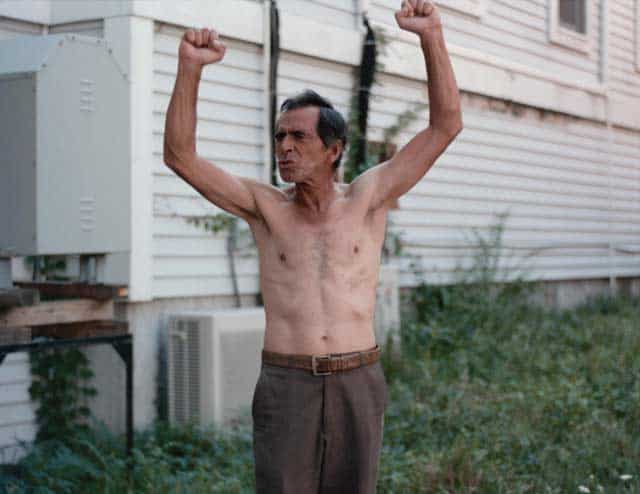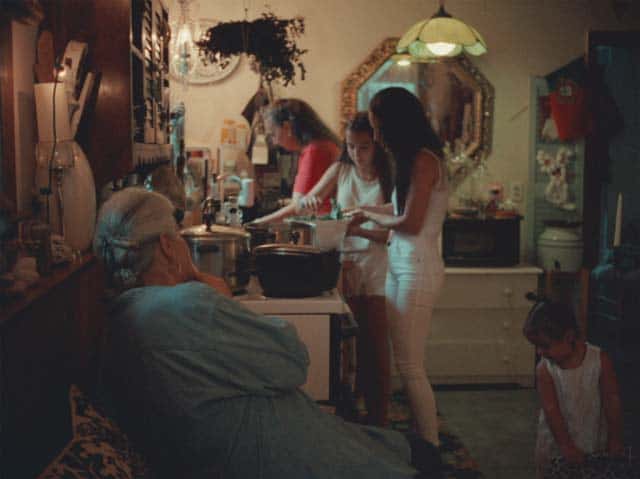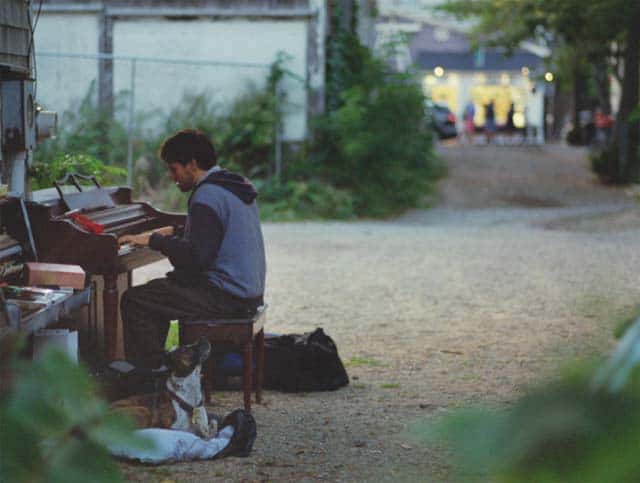by Rebecca M. Alvin
All Images from Mischa Richter’s I Am a Town © 2019
On a Saturday afternoon in late June, just a week after what would have been the 22nd annual Provincetown International Film Festival (PIFF), Mischa Richter is thoughtful about how he might be able to screen I Am a Town, his feature documentary about Provincetown, with that festival canceled along with most others due to the pandemic and movie theaters not yet allowed to reopen.
“Maybe a beach screening. You know the house boats out there?” he suggests. “Mike Winkler who does the cranes, he has the houseboat and he knows the guys from the [Schooner] Hindu, and the Hindu will tie up on his houseboat’s rope and they project onto the sail and watch all kinds of movies. I would like to do something like that. That would be incredible on a very low tide. And have social distancing along a bay beach with projection onto a screen out there. I don’t know if that’s logistically possible, but it would be great.”

Thankfully, PIFF recently announced that they will hold a “reimagined” festival July 16 –19, utilizing the nearby Wellfleet Drive-In as its screening venue, with Richter’s film the opening night selection.
I Am a Town is an extraordinarily beautiful meditation on Provincetown from the perspective of someone who grew up here and whose family has been connected to the town for 100 years. It features interviews with a variety of people in town, highlighting the complex layers of meaning that Provincetown holds for people, and yet somehow coalescing in a vision quite specific to Richter himself.
“The thing that I think is so great about Provincetown is that I think there are infinite spirits of the town, you know what I mean?” Richter says. “I think it’s like a community and working together, accepting one another. This idea that we live in quite an exposed environment and we’re jutted out in the middle of the sea. And that town was built on a very treacherous industry, whaling and fishing, and the spirit is to help each other out because we need each other. That’s what I kind of grew up with, that spirit.”

Multiple generations of a Portuguese family.
Although the film premiered at the prestigious Doc Fortnight festival at the Museum of Modern Art in New York earlier this year, screening here in Provincetown is still an essential part of Richter’s plan.
“I had this crazy scheme, where I wanted to do a tour of national parks, and I wanted to project it outdoors in maybe like ten parks around the country or something. I wanted to do something a little differently to bring the film and the idea of watching a film into some place maybe you wouldn’t. And I wanted to start with the [Province Lands] Visitors’ Center in Provincetown with that ampitheater, which I feel just doesn’t get used enough,” he muses. “That’s one of my dreams, so maybe in the future that’s possible.”
I Am a Town highlights the characters that have made up the fabric of the town, apart from the touristy summer scene. The late writer Roger Skillings, artist Pat deGroot, and of course local fixture Freddie Rocha, Jr., all of whom are now gone, are some of the notable subjects, although de Groot does not directly appear in the film. These individuals, with their difficult, complex personalities, who represented something and made the town real even during the hedonistic, carefree summers, are disappearing. The film documents their impact.
For example, Kiah Coble is a young artist who spent a lot of time with de Groot and learned much from her. She speaks in the film about what she meant to her, about how inspiring it was to be around someone who—though very difficult at times—was able to live life on her own terms in a house overlooking the bay, making art, and doing as she pleased: the bohemian dream. It’s a far cry from the million dollar renovated homes made at the expense of historical preservation and lived in only a couple of months out of the year. It takes a certain personality, a certain strength and determination to live here year-round, and that comes through in the stories of those in I Am a Town.
But you won’t see titles identifying who’s who. In a way, this gives those of us who are year-round and actually know—or know of—the people in the film a little special thrill watching it, knowing that people who are just visitors don’t know what we know. But Richter’s strategy was more conceptual than that.

Paul Tasha
“It wasn’t about who they specifically were, but it was about how they function in the town and how they might relate to others in town,” he explains. “As a child there were certain things about the town that slowly revealed themselves to me… that made me think this is a special place, like equality, or like how Paul [Tasha] was so interested in the land and parts of the land, and he would do things to protect it. And I went hunting with him when we were young, and we would stalk a deer for hours and then decide not to shoot it because we couldn’t bear to see it die. Those sorts of ideas made me think, ‘wow, this is a special beautiful place. The way a lot of people are thinking here, it’s kind of righteous.’ So I wanted to illustrate those ideas.”
Richter came to Provincetown at four years old from the Chelsea Hotel in New York City, where he was living with his family in the 1970s. As fascinating a place as that storied hotel was back then, it was not a great place for a child to grow up. Provincetown brought things to Richter’s life that have shaped him and supported him as an artist and successful photographer who built a career in commercial and editorial photography and photographed Amy Winehouse for her Back to Black album. His film is part of a larger project documenting Provincetown with portraits of its people and its iconic symbols, such as the orange dory owned by the late Eddie Ritter, to whom the film is dedicated. Some of these images are on view in an exhibition at Albert Merola Gallery now through July 22.
“The photos of the portraits that I’m hanging up, I first put these portraits in the windows [above Shalom Gifts]—as you see in the film I’m putting them up—and that was the first time we shot for the film, and that was probably five years ago… .And those portraits I put in those windows, first of all, because they were important characters that I felt were really part of the town that were then gone. So I wanted to keep their spirit alive and I thought it would be an interesting place to create this almost memorial to them through these windows of the building in the middle of town. Also, I wanted to start to make work that ages and is affected by the sun or bugs or weather. So now I am hanging those portraits in Albert Merola Gallery. I feel like when I first hang those in the gallery, then I have made that work of art, that it took 5 or 6 years to make it, and there was this sort of process that they had to go through.”

Will Herrington
The film beautifully depicts our landscape and the ocean that dominates everything out here, but it is through the people and their understandings of this place that make Provincetown what it is. Richter recalls growing up in Provincetown as a young, straight man and his shifting views as a kid with regard to the town’s reputation as an LGBTQ destination.
“You know, I would play on teams for the schools and we would go travel along the Cape and we were teased, we were called—I don’t want to say the word, but you can imagine the word we were called. So we almost had homophobia in ourselves because of that, and we were sort of pigeonholed in this thing,” he explains. “But then, very early on I realized that that was a special thing, that we come from this place where it’s okay to be who you are.”
Recognizing the town’s LGBTQ community, as well as its Portuguese roots and contemporary Jamaican community, I Am a Town is successful in painting a portrait of a diverse place that holds strong meanings for a lot of different people and different communities. Wanting to include people who more recently discovered Provincetown, Richter includes photographer Ryan McGinley and his partner Marc Armitano, who moved here from New York.
“Even in New York City, which is a cosmopolitan place, Ryan’s still worried about walking down the street holding [Marc’s] hand. They come to Provincetown and there’s no thought of that. If anything, they hold each other’s hand more because they can. And some fishemen walk by—they couldn’t care less, you know, in like 100 years they couldn’t care less,” Richter says.
I Am a Town is pensive. The sound design is stark and the imagery is wide open spatially. This is not an exposé about a changing town. This is not a television-style documentary. This is a cinematic exploration of Provincetown; it represents his sense of this place, visually and aurally, so that the form itself tells you what you need to know about the town.
Richter consciously made the film this way. “I never wanted to make a film which was hard journalism or an investigation of a place in that way. I wanted it to be a subtle look at these people. Like the Portuguese family, that’s four generations of women in a Portuguese family,” he says. “I wanted to talk about that history and this immigration and how important for our country—not for Provincetown, but for our country—how important this immigration is… And I thought the way to do it was just to spend time with them and not talk to them too much about what we’re doing, and that history would come out, those ideas would come out.”
While tourists may look at Provincetown as a place that is bustling in the summer, with drag queens barking on every corner, a lively bar and nightclub scene, and an especially open atmosphere, Richter brings it back to that bohemian nature. Contemplating whether or not the deaths of many of these characters, these people not only in Richter’s film, but also in his larger body of work over the past several years, actually changes what Provincetown is, Richter isn’t sure. “I’ve thought about this a lot. And part of me feels like these characters could exist because of the way the town is, because of this almost celebration of eccentricities and individualism,” he says thoughtfully. “Does that mean that there are new characters who will take their place? I don’t know. A friend of mine did say something to me last summer, saying ‘You are becoming one of those characters,’” Richter laughs. “There are certain aspects of the town that are changing. Like most of the world and other places that become popular destinations, just financially it’s tough to be there and to really be free and maybe eccentric. Can you be that person still in Provincetown?… Can a young artist who wants to express themselves and be a little different, can they be there if they don’t have any money? I don’t know if those go together or not, but we’ll see. I don’t know. Were gonna see what happens.”
I Am a Town is the opening night screening for the reimagined Provincetown International Film Festival, which takes place July 16 – 19 at the Wellfleet Drive-In, at the Eastham-Wellfleet town line on Route 6. His film will be preceded by the short film Save Yourselves! The show begins at 8:35 p.m. Advance tickets are REQUIRED. Purchase online at provincetownfilm.org. For more information call 508.413.9369. His exhibition may be viewed by appointment only at Albert Merola Gallery, 424 Commercial St., Provincetown, through July 22. For more information call 508.487.4424 or visit albertmerolagallery.com.











